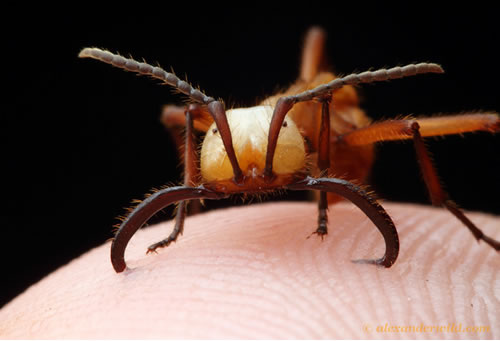The ant's ice-tong mandibles latch onto the enemy and give her the leverage to use her stinger at the rear end of the ant. This makes her very difficult to remove (notice the mandible buried deep inside the skin).
The soldier caste of Eciton hamatum is similar to that of E. burchellii, bearing the same defensive tusks. Eciton hamatum soldiers, though, have a much larger set of horns along the back corners of the head. These protrusions presumably protect the ant’s vulnerable neck in fights with other ants, and this species certainly spends a great deal more time fighting other ants than does E. burchellii.Despite the scary look, Alex told us that E. hamatum isn't actually that bad:
If you’ve got an assignment to shoot army ants and your editor neglects to specify the species, I’d hold out for these guys. You won’t get swarmed over, gored, bitten, stung up, or otherwise assaulted anywhere near the amount you suffer by approaching the vicious E. burchellii. [...]Check out more of Alex Wild's fantastic photographs of Army Ants from around the world: Full Story | Gallery
On a personal note, I found photographing this species to be great fun. Most of my Eciton encounters over the years have been with E. burchellii or E. vagans. In comparison, E. hamatum is charming. Their physique is a bit more pudgy, they are an unusual shade of orange, and they are much less aggressive. The effect is almost comical.


No comments:
Post a Comment